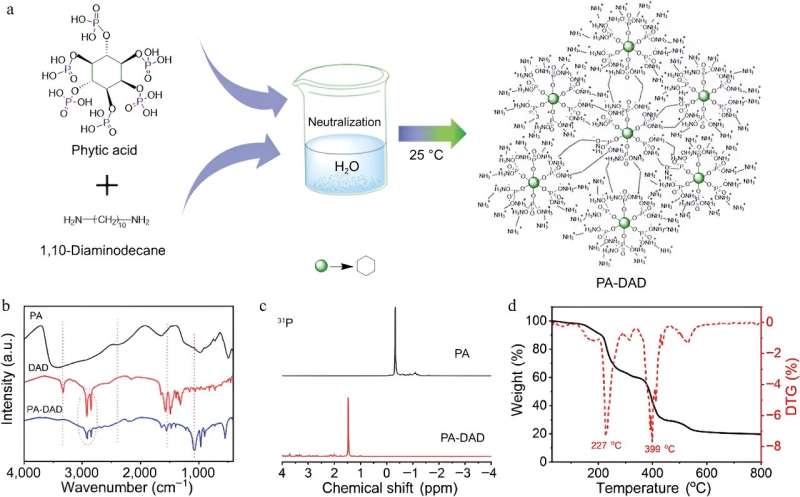This article has been reviewed according to Science X's editorial process and policies. Editors have highlighted the following attributes while ensuring the content's credibility:
fact-checked
proofread
Enhancing fire safety: The emergence of PA-DAD as a sustainable flame retardant for epoxy resin composites

Epoxy resin (EP), an essential material in various applications such as adhesives, coatings, and composites, faces challenges due to its intrinsic flammability and dense smoke production, posing threats to safety and property. To address these issues, modifications to enhance flame retardancy are imperative.
Although numerous flame retardants (FRs) have been developed, most derive from non-renewable sources, conflicting with sustainability goals. Recently, bio-based FRs like phytic acid (PA) have gained attention for their renewable, abundant, and biodegradable nature. Among these, PA stands out for its high flame-retardant efficiency due to its significant phosphorus content. However, the challenge remains as some bio-based FRs still rely on petroleum-based products for effectiveness.
On this topic, Emergency Management Science and Technology has published a research article titled "A bio-based hyperbranched flame retardant towards the fire-safety and smoke-suppression epoxy composite."
This study details the innovative development and comprehensive characterization of a fully biological flame retardant named PA-DAD, created through a straightforward neutralization reaction between 1,10-diaminodecane (DAD) and phytic acid (PA). Fourier-transform infrared spectroscopy (FTIR), nuclear magnetic resonance (NMR), and differential scanning calorimetry (DSC) analyses confirmed the successful synthesis of PA-DAD, demonstrating changes in chemical bonding indicative of flame retardant formation.
This bio-based flame retardant was then incorporated into epoxy resin (EP) composites to investigate its impact on flame retardancy and mechanical properties. The addition of PA-DAD significantly improved the limiting oxygen index (LOI) values and UL-94 ratings of the EP composites, showcasing its efficacy in enhancing fire resistance.
Thermogravimetric analysis (TGA) and cone calorimetry tests further revealed that PA-DAD increased the char yield and reduced the peak heat release rate (RR), total smoke production (TSP), and toxic gas emissions during combustion, thereby affirming its superior flame-retardant efficacy.
The formation of a dense, intumescent char layer acted as a thermal barrier, reducing heat and mass transfer during combustion. During the combustion process, the decomposition of PA-DAD can produce products with P-O-C, PO·, and NH3, thereby capturing active free radicals of H· and OH·, reducing the emissions of oxygen and toxic gases, and preventing the continuous degradation of the substrate.
Moreover, the study explored the mechanical properties of EP composites, noting enhanced tensile, flexural, and impact strengths with the addition of PA-DAD, attributed to the increased crosslink density and energy dissipation capabilities of the ion bonds formed by PA-DAD.
In conclusion, PA-DAD emerges as an exceptionally efficient and environmentally sustainable flame retardant, which not only markedly enhances the fire safety profile of epoxy resin (EP) composites but also preserves or improves their mechanical properties. This work underscores the potential of using bio-based materials for fire safety applications, offering a promising avenue for the development of sustainable, high-performance flame retardants.
The findings hold substantial value for future applications in creating safer, more environmentally friendly fire-retardant materials, marking a noteworthy contribution to the field of materials science and engineering.
More information: Zhiqian Lin et al, A bio-based hyperbranched flame retardant towards the fire-safety and smoke-suppression epoxy composite, Emergency Management Science and Technology (2023). DOI: 10.48130/EMST-2023-0021
Provided by Maximum Academic Press





















